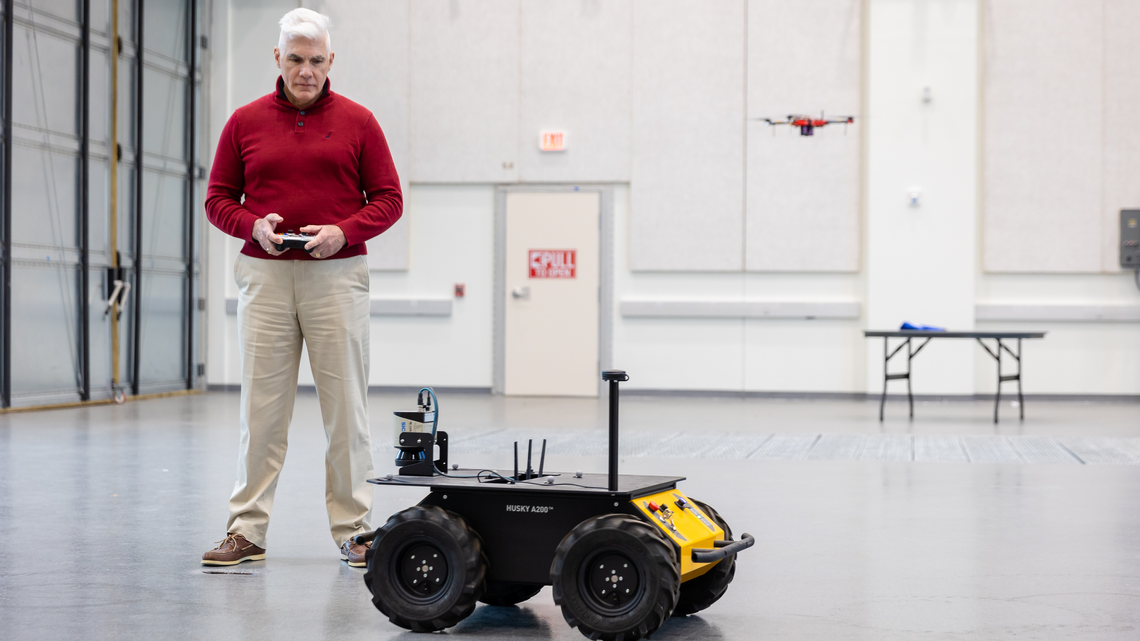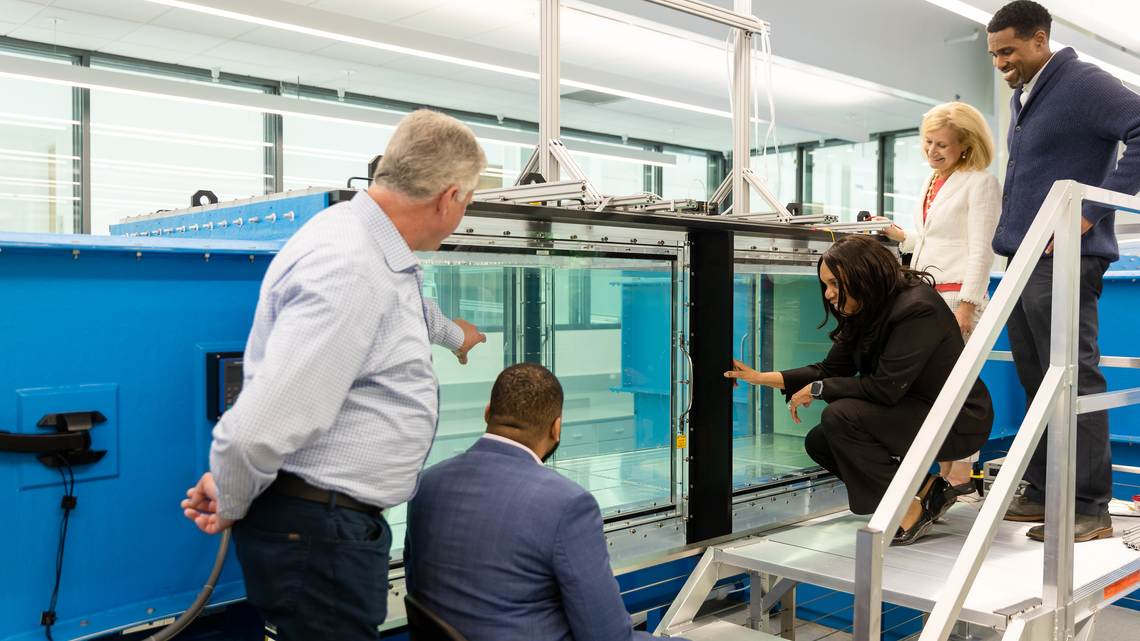
Tracking drones and robots with pinpoint precision in an open air-land lab; watching students build and test their prototypes in a large project assembly space; creating an autonomous school of robotic fish in a water tunnel – it’s all in a day’s work for the people who study, teach and conduct research in the Southern Maryland Autonomous Research and Technology (SMART) Building, on the campus of the University System of Maryland Southern Maryland (USMSM).
“If they put teeth on it, I’m getting out of the water!” joked Matt Scassero, director of Operations and Outreach at the University of Maryland (UMD) Clark School of Engineering’s MATRIX Lab, which is housed in the SMART Building. Biting robotic fish aside, Scassero is an enthusiastic supporter of all the autonomy-focused SMART building offers its users.
“The SMART Building is a really interesting collaboration of education and research. It’s both physically and conceptually designed for working together, to have students involved in the research and researchers involved in the education programming – because that’s how we develop our workforce of the future,” said Scassero.
Part of the AeroPark Innovation District, the 84,000-square-foot building feels like the future. Housing the MATRIX Lab, the SMART Building offers students and faculty leading-edge underwater, air and land testing facilities. But that’s not all. The SMART Building also provides unique opportunity for students and faculty, allowing them to combine education and research, promoting the advancement of innovation while simultaneously encouraging talent retention in Maryland.

Students applaud the program and the building, citing the excellent faculty who are readily available, the innovative space and research opportunities, and the close relationships with real-world partners, including relationships they develop through a myriad of local internships.
This SMART building houses robotic fish and Southern Maryland’s future workforce
The SMART Building is much more than an education center. It’s a place of opportunities; often, students don’t realize just how close to home these opportunities are.
“Engineering wasn’t my first choice. I grew up on the automotive side of things,” said one student whose father was a car mechanic. He discovered the UMD engineering program in the SMART Building at USMSM and decided to give mechanical engineering a try. “I fell in love with it and got a great job at NAWCAD, which really was the goal – to stay here and stay local.”
Local employers recognize many members of their future workforce may share this desire to stay in the area. That’s one reason they strive to get involved early.
Keeping talent in Maryland: Attracting innovators and future leaders
The SMART Building is much more than an education center. It’s a place of opportunities; often, students don’t realize just how close to home these opportunities are. That’s something Maria Thorpe works to change.
As director of the Human Systems Engineering Department at The Naval Air Warfare Center Aircraft Division (NAWCAD), Thorpe offers internships and outreach to students and families in Southern Maryland. She informs students taking classes at the SMART Building about NAWCAD, the important and innovative work they do, and the opportunities NAWCAD presents, including those allowing students to work locally.
“I believe in outreach and finding the next generation of talent. I work to get students on base to see a day in the life of an engineer … and I involve the family, so they understand the pathways for their children,” said Thorpe.
Thorpe’s work is part of a strategic effort, one that brings together industry, academia and government partners. NAWCAD, the University of Maryland and USMSM are all key partners in Southern Maryland’s portion of the “autonomy corridor.” In fact, the SMART Building hosted a Maryland Autonomy Summit in late 2022 that brought together many of the region’s government agencies and industry partners with a focus on autonomy and uncrewed systems.
Rick Tarr, director of the NAWCAD Technology Transfer Office, notes many benefits of the SMART Building, benefits that support NAWCAD as well as the community of over 300 industry partners and organizations like TEDCO that invest in the startup community. In addition to preparing NAWCAD’s workforce, the SMART Building is also a space to develop key technologies for future use.
“The Smart Building gives us the ability to experiment with our industry partners, bringing new industry solutions and technologies into an experimentation site to see about their viability for solving fleet and warfighter problems,” said Tarr.
“It’s clear that the SMART Building’s unique offerings, coupled with resources and support from a number of partners – TEDCO, the Navy, industry and education – contribute to Southern Maryland’s success,” said Troy LeMaile-Stovall, TEDCO CEO. “Whether it’s helping STEM entrepreneurs successfully launch or graduating new members of the STEM workforce, the future looks bright from the vantage of the SMART building.”
If you visit the building, just be sure to watch out for robotic fish.
TEDCO, the Maryland Technology Development Corporation, enhances economic empowerment growth through the fostering of an inclusive entrepreneurial innovation ecosystem. TEDCO identifies, invests in and helps grow technology and life science-based companies in Maryland. Learn more at www.tedcomd.com.
Tammi Thomas is chief development and marketing officer at TEDCO.
Source: Washington Business Journal